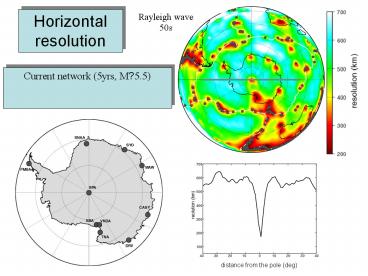Horizontal resolution - PowerPoint PPT Presentation
1 / 12
Title:
Horizontal resolution
Description:
... Ambient Noise in Antarctica? Results: Vs and temperature across Antarctica. 100 km depth ... Antarctica. Results: Lithospheric thickness vs mantle heat ... – PowerPoint PPT presentation
Number of Views:100
Avg rating:3.0/5.0
Title: Horizontal resolution
1
Horizontalresolution
Rayleigh wave 50s
Current network (5yrs, M5.5)
distance from the pole (deg)
2
Horizontalresolution
Rayleigh wave 50s
Current network (5yrs, M5.5) New permanent stati
ons (5yrs, M5.5)
distance from the pole (deg)
3
Horizontalresolution
Rayleigh wave 50s
Current network (5yrs, M5.5) New permanent stati
ons (5yrs, M5.5)
Regional arrays (1yr, M5.0)
distance from the pole (deg)
4
Green Functions by Cross-Correlating Ambient
Noise in Antarctica?
Record section Cross-correlate
1 month of ambient noise, Z
Bandpass centered on 20 sec
20 sec period Rayleigh wave
5
Results Vs and temperature across Antarctica
100 km depth
W. vs E. Antarctica _at_100 km 1000 deg di
fference. _at_ 300 km. 400 deg differenc
e. Along Transantarctic Mtns _at_ 100 km, 1deg
/km laterally. E. Antarctic cratonic core 300
km thick, but much thinner nearer the coast.
6
Results Vs and temperature across Antarctica
100 km depth
W. Ant. Rift
E. Ant. Craton
So. Pole
A
A
temp
W. vs E. Antarctica _at_100 km 1000 deg di
fference. _at_ 300 km. 400 deg differenc
e. Along Transantarctic Mtns _at_ 100 km, 1deg
/km laterally. E. Antarctic cratonic core 300
km thick, but much thinner nearer the coast.
7
Other cratons lithospheric thickness
Results Lithospheric thickness compared with
other continents
8
Results Mantle heat flow compared with other
continents
9
Mean of the Extrapolated Distribution
Shapiro Ritzwoller, EPSL, 2004,
10
Results Lithospheric thickness vs mantle heat
flow compared with other continents
Other Continents
Antarctica
11
Results Lithospheric thickness vs mantle heat
flow compared with other continents
Other Continents
Antarctica
12
Anomalous Mantle Structure Beneath Antarctica?
Locations with relatively thin lithosphere
but low heat flux. Cause? Erosion of the con
tinental roots caused by Mesozoic rifting? or
Simply poor lateral resolution?































